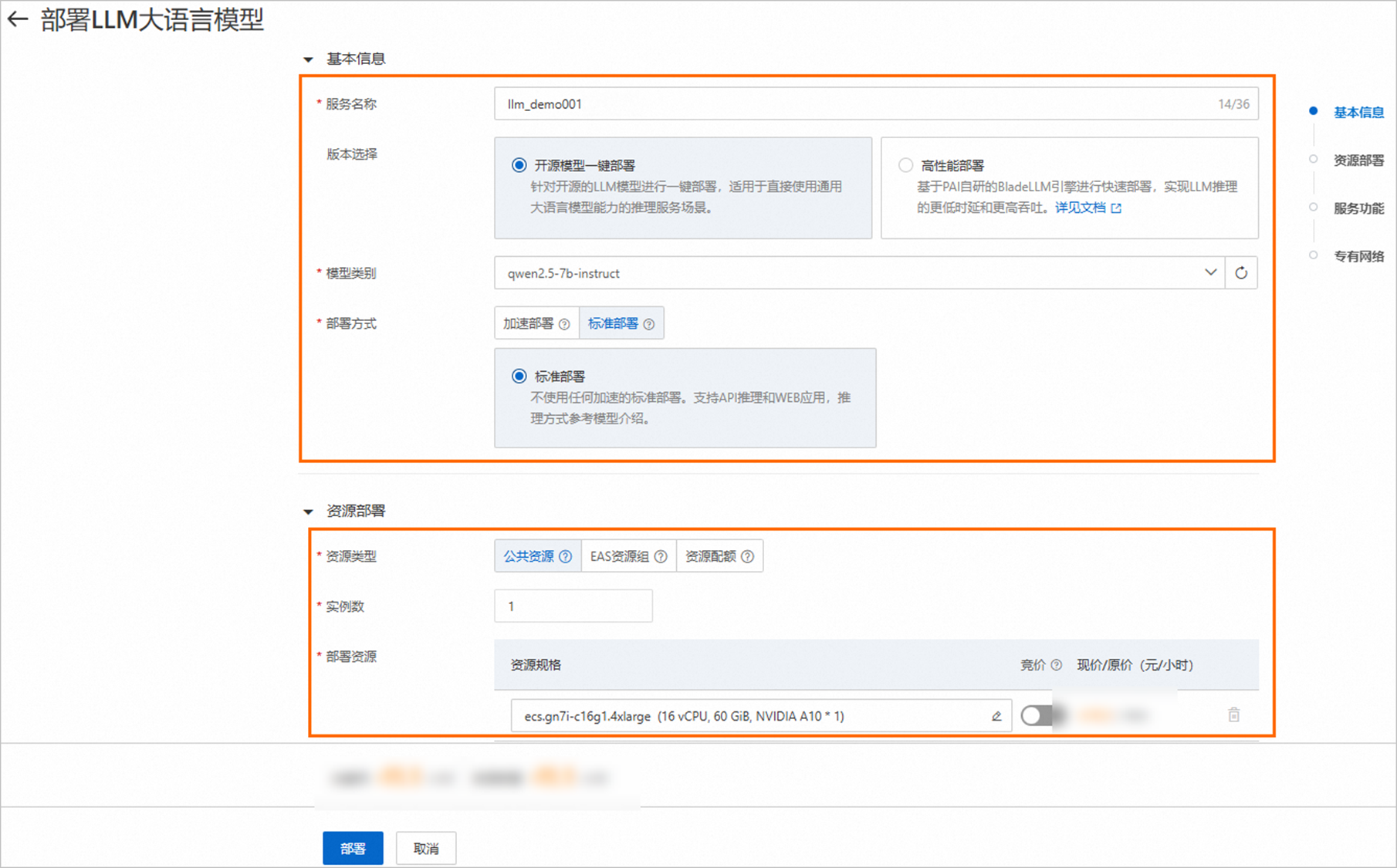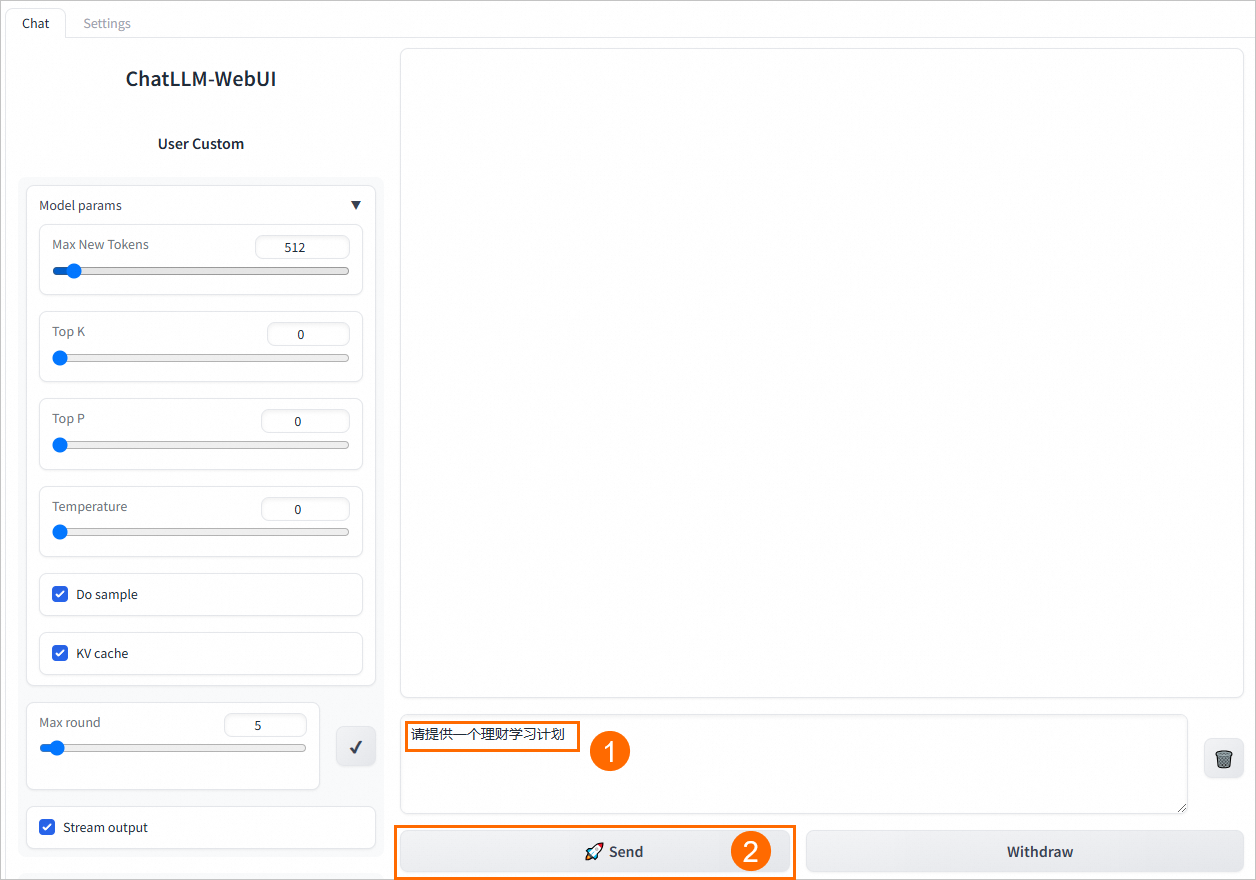EAS(Elastic Algorithm Service)是PAI為線上推理情境提供的模型線上服務,為自動化部署和應用LLM大語言模型提供了一鍵式解決方案。通過EAS,您可以輕鬆部署多種開源大模型服務應用,同時支援標準部署、加速部署:BladeLLM和加速部署:vLLM三種部署方式,使用加速部署,您可以體驗到高並發和低延遲的技術優勢。本文為您介紹如何通過EAS一鍵部署和調用LLM大語言模型,以及常見的問題和解決方案。
前提條件
已開通PAI並建立預設工作空間,詳情請參見開通並建立預設工作空間。
如果使用RAM使用者來部署模型,需要為RAM使用者授予EAS的系統管理權限,詳情請參見雲產品依賴與授權:EAS。
部署EAS服務
進入模型線上服務頁面。
登入PAI控制台。
在左側導覽列單擊工作空間列表,在工作空間列表頁面中單擊待操作的工作空間名稱,進入對應工作空間內。
在工作空間頁面的左側導覽列選擇模型部署>模型線上服務(EAS),進入模型線上服務(EAS)頁面。

在模型線上服務(EAS)頁面,單擊部署服務,然後在情境化模型部署地區,單擊LLM大語言模型部署。
在部署LLM大語言模型頁面,配置以下關鍵參數,其他參數使用預設配置。
參數
描述
基本資料
服務名稱
自訂服務名稱。本方案使用的樣本值為:llm_demo001。
版本選擇
選擇開源模型一鍵部署。
模型類別
本方案選擇qwen2.5-7b-instruct。EAS還提供了多種模型類別可供選擇,以滿足您的不同需求,例如DeepSeek-R1、Qwen2-VL、Meta-Llama-3.2-1B等。
部署方式
選擇標準部署,不使用任何加速架構。
資源部署
資源類型
選擇公用資源。
部署資源
選擇模型類別後,系統會自動推薦適合的資源規格。

單擊部署,大約等待5分鐘後即可完成模型部署。
啟動WebUI進行模型推理
單擊目標服務服務方式列下的查看Web應用。

在WebUI頁面,進行模型推理驗證。
在ChatLLM-WebUI頁面的文字框中輸入對話內容,例如
請提供一個理財學習計劃,單擊Send,即可開始對話。
常見問題及解決方案
如何切換其他的開源大模型?
您可以在EAS上快速從第三方拉起DeepSeek-R1、Llama、UI-TARS、QVQ、gemma2、以及baichuan2等開源大模型檔案,參考以下操作步驟切換並部署這些模型:
單擊目標服務操作列下的更新。
更新模型類別為其他開源大模型,系統將同步更新資源規格。
單擊更新。
如何提升推理並發且降低延遲?
EAS支援BladeLLM和vLLM的推理加速引擎,可以協助您一鍵享受高並發和低延時的技術紅利。具體操作步驟如下:
單擊目標服務操作列下的更新。
在基本資料地區,更新部署方式為加速部署,並選擇加速框為BladeLLM或vLLM。
單擊更新。
您也可以在部署LLM大語言模型時,將部署版本選擇高效能部署,基於PAI自研的BladeLLM引擎進行快速部署。具體操作,請參見BladeLLM快速入門。
如何掛載自訂模型?
當部署版本選擇高效能部署時,支援掛載自訂模型。僅支援部署Qwen和Llama全系列文本模型,包括開源版本、微調版本以及量化後的版本。以OSS掛載為例,具體操作步驟如下:
將自訂模型及相關設定檔上傳到您自己的OSS Bucket目錄中,關於如何建立儲存空間和上傳檔案,詳情請參見控制台建立儲存空間和控制台上傳檔案。
需要準備的模型檔案範例如下:

其中設定檔中必須包含config.json檔案,您需要按照Huggingface或的模型格式配置Config檔案。樣本檔案詳情,請參見config.json。
單擊目標服務操作列下的更新。
在部署LLM大語言模型頁面,配置以下參數,參數配置完成後,單擊更新。
參數
描述
基本資料
版本選擇
選擇高效能部署。
鏡像版本
選擇blade-llm:0.9.0。
模型配置
選擇自訂模型,單擊OSS,並選擇自訂模型所在的OSS儲存路徑。
資源部署
部署資源
參考使用限制,選擇資源規格。
如何使用API進行模型推理?
根據您所採用的部署方式,調用方法會有所不同。請依據您的具體部署版本,選取合適的調用方法。
標準部署
擷取服務訪問地址和Token。
訪問模型線上服務(EAS),選擇工作空間後,進入EAS。
單擊目標服務名稱,進入服務詳情頁面。
在基本資料地區單擊查看調用資訊,在公網地址調用頁簽擷取服務Token和訪問地址。
啟動API進行模型推理。
使用HTTP方式調用服務
非流式調用
用戶端使用標準的HTTP格式,使用命令列調用時,支援發送以下兩種類型的請求:
發送String類型的請求
curl $host -H 'Authorization: $authorization' --data-binary @chatllm_data.txt -v其中:$authorization需替換為服務Token;$host:需替換為服務訪問地址;chatllm_data.txt:該檔案為包含問題的純文字檔案,例如
加拿大的首都是哪裡?。發送結構化類型的請求
curl $host -H 'Authorization: $authorization' -H "Content-type: application/json" --data-binary @chatllm_data.json -v -H "Connection: close"使用chatllm_data.json檔案來設定推理參數,chatllm_data.json檔案的內容格式如下:
{ "max_new_tokens": 4096, "use_stream_chat": false, "prompt": "What is the capital of Canada?", "system_prompt": "Act like you are a knowledgeable assistant who can provide information on geography and related topics.", "history": [ [ "Can you tell me what's the capital of France?", "The capital of France is Paris." ] ], "temperature": 0.8, "top_k": 10, "top_p": 0.8, "do_sample": true, "use_cache": true }參數說明如下,請酌情添加或刪除。
參數
描述
預設值
max_new_tokens
產生輸出token的最大長度,單位為個。
2048
use_stream_chat
是否使用流式輸出形式。
true
prompt
使用者的Prompt。
""
system_prompt
系統Prompt。
""
history
對話的記錄,類型為List[Tuple(str, str)]。
[()]
temperature
用於調節模型輸出結果的隨機性,值越大隨機性越強,0值為固定輸出。Float類型,區間為0~1。
0.95
top_k
從產生結果中選擇候選輸出的數量。
30
top_p
從產生結果中按百分比選擇輸出結果。Float類型,區間為0~1。
0.8
do_sample
開啟輸出採樣。
true
use_cache
開啟KV Cache。
true
您可以使用Python的requests庫來構建自己的用戶端,範例程式碼如下。您可以通過命令列參數
--prompt來指定請求的內容,例如:python xxx.py --prompt "What is the capital of Canada?"。import argparse import json from typing import Iterable, List import requests def post_http_request(prompt: str, system_prompt: str, history: list, host: str, authorization: str, max_new_tokens: int = 2048, temperature: float = 0.95, top_k: int = 1, top_p: float = 0.8, langchain: bool = False, use_stream_chat: bool = False) -> requests.Response: headers = { "User-Agent": "Test Client", "Authorization": f"{authorization}" } if not history: history = [ ( "San Francisco is a", "city located in the state of California in the United States. \ It is known for its iconic landmarks, such as the Golden Gate Bridge \ and Alcatraz Island, as well as its vibrant culture, diverse population, \ and tech industry. The city is also home to many famous companies and \ startups, including Google, Apple, and Twitter." ) ] pload = { "prompt": prompt, "system_prompt": system_prompt, "top_k": top_k, "top_p": top_p, "temperature": temperature, "max_new_tokens": max_new_tokens, "use_stream_chat": use_stream_chat, "history": history } if langchain: pload["langchain"] = langchain response = requests.post(host, headers=headers, json=pload, stream=use_stream_chat) return response def get_response(response: requests.Response) -> List[str]: data = json.loads(response.content) output = data["response"] history = data["history"] return output, history if __name__ == "__main__": parser = argparse.ArgumentParser() parser.add_argument("--top-k", type=int, default=4) parser.add_argument("--top-p", type=float, default=0.8) parser.add_argument("--max-new-tokens", type=int, default=2048) parser.add_argument("--temperature", type=float, default=0.95) parser.add_argument("--prompt", type=str, default="How can I get there?") parser.add_argument("--langchain", action="store_true") args = parser.parse_args() prompt = args.prompt top_k = args.top_k top_p = args.top_p use_stream_chat = False temperature = args.temperature langchain = args.langchain max_new_tokens = args.max_new_tokens host = "EAS服務公網地址" authorization = "EAS服務公網Token" print(f"Prompt: {prompt!r}\n", flush=True) # 在用戶端請求中可設定語言模型的system prompt。 system_prompt = "Act like you are programmer with \ 5+ years of experience." # 用戶端請求中可設定對話的歷史資訊,用戶端維護目前使用者的對話記錄,用於實現多輪對話。通常情況下可以使用上一輪對話返回的histroy資訊,history格式為List[Tuple(str, str)]。 history = [] response = post_http_request( prompt, system_prompt, history, host, authorization, max_new_tokens, temperature, top_k, top_p, langchain=langchain, use_stream_chat=use_stream_chat) output, history = get_response(response) print(f" --- output: {output} \n --- history: {history}", flush=True) # 服務端返回JSON格式的響應結果,包含推理結果與對話歷史。 def get_response(response: requests.Response) -> List[str]: data = json.loads(response.content) output = data["response"] history = data["history"] return output, history其中:
host:配置為服務訪問地址。
authorization:配置為服務Token。
流式調用
流式調用使用HTTP SSE方式,其他設定與非流式相同,代碼參考如下。您可以通過命令列參數
--prompt來指定請求的內容,例如python xxx.py --prompt "What is the capital of Canada?"。import argparse import json from typing import Iterable, List import requests def clear_line(n: int = 1) -> None: LINE_UP = '\033[1A' LINE_CLEAR = '\x1b[2K' for _ in range(n): print(LINE_UP, end=LINE_CLEAR, flush=True) def post_http_request(prompt: str, system_prompt: str, history: list, host: str, authorization: str, max_new_tokens: int = 2048, temperature: float = 0.95, top_k: int = 1, top_p: float = 0.8, langchain: bool = False, use_stream_chat: bool = False) -> requests.Response: headers = { "User-Agent": "Test Client", "Authorization": f"{authorization}" } if not history: history = [ ( "San Francisco is a", "city located in the state of California in the United States. \ It is known for its iconic landmarks, such as the Golden Gate Bridge \ and Alcatraz Island, as well as its vibrant culture, diverse population, \ and tech industry. The city is also home to many famous companies and \ startups, including Google, Apple, and Twitter." ) ] pload = { "prompt": prompt, "system_prompt": system_prompt, "top_k": top_k, "top_p": top_p, "temperature": temperature, "max_new_tokens": max_new_tokens, "use_stream_chat": use_stream_chat, "history": history } if langchain: pload["langchain"] = langchain response = requests.post(host, headers=headers, json=pload, stream=use_stream_chat) return response def get_streaming_response(response: requests.Response) -> Iterable[List[str]]: for chunk in response.iter_lines(chunk_size=8192, decode_unicode=False, delimiter=b"\0"): if chunk: data = json.loads(chunk.decode("utf-8")) output = data["response"] history = data["history"] yield output, history if __name__ == "__main__": parser = argparse.ArgumentParser() parser.add_argument("--top-k", type=int, default=4) parser.add_argument("--top-p", type=float, default=0.8) parser.add_argument("--max-new-tokens", type=int, default=2048) parser.add_argument("--temperature", type=float, default=0.95) parser.add_argument("--prompt", type=str, default="How can I get there?") parser.add_argument("--langchain", action="store_true") args = parser.parse_args() prompt = args.prompt top_k = args.top_k top_p = args.top_p use_stream_chat = True temperature = args.temperature langchain = args.langchain max_new_tokens = args.max_new_tokens host = "" authorization = "" print(f"Prompt: {prompt!r}\n", flush=True) system_prompt = "Act like you are programmer with \ 5+ years of experience." history = [] response = post_http_request( prompt, system_prompt, history, host, authorization, max_new_tokens, temperature, top_k, top_p, langchain=langchain, use_stream_chat=use_stream_chat) for h, history in get_streaming_response(response): print( f" --- stream line: {h} \n --- history: {history}", flush=True)其中:
host:配置為服務訪問地址。
authorization:配置為服務Token。
使用WebSocket方式調用服務
為了更好地維護使用者對話資訊,您也可以使用WebSocket方式保持與服務的串連完成單輪或多輪對話,程式碼範例如下:
import os import time import json import struct from multiprocessing import Process import websocket round = 5 questions = 0 def on_message_1(ws, message): if message == "<EOS>": print('pid-{} timestamp-({}) receives end message: {}'.format(os.getpid(), time.time(), message), flush=True) ws.send(struct.pack('!H', 1000), websocket.ABNF.OPCODE_CLOSE) else: print("{}".format(time.time())) print('pid-{} timestamp-({}) --- message received: {}'.format(os.getpid(), time.time(), message), flush=True) def on_message_2(ws, message): global questions print('pid-{} --- message received: {}'.format(os.getpid(), message)) # end the client-side streaming if message == "<EOS>": questions = questions + 1 if questions == 5: ws.send(struct.pack('!H', 1000), websocket.ABNF.OPCODE_CLOSE) def on_message_3(ws, message): print('pid-{} --- message received: {}'.format(os.getpid(), message)) # end the client-side streaming ws.send(struct.pack('!H', 1000), websocket.ABNF.OPCODE_CLOSE) def on_error(ws, error): print('error happened: ', str(error)) def on_close(ws, a, b): print("### closed ###", a, b) def on_pong(ws, pong): print('pong:', pong) # stream chat validation test def on_open_1(ws): print('Opening Websocket connection to the server ... ') params_dict = {} params_dict['prompt'] = """Show me a golang code example: """ params_dict['temperature'] = 0.9 params_dict['top_p'] = 0.1 params_dict['top_k'] = 30 params_dict['max_new_tokens'] = 2048 params_dict['do_sample'] = True raw_req = json.dumps(params_dict, ensure_ascii=False).encode('utf8') # raw_req = f"""To open a Websocket connection to the server: """ ws.send(raw_req) # end the client-side streaming # multi-round query validation test def on_open_2(ws): global round print('Opening Websocket connection to the server ... ') params_dict = {"max_new_tokens": 6144} params_dict['temperature'] = 0.9 params_dict['top_p'] = 0.1 params_dict['top_k'] = 30 params_dict['use_stream_chat'] = True params_dict['prompt'] = "您好!" params_dict = { "system_prompt": "Act like you are programmer with 5+ years of experience." } raw_req = json.dumps(params_dict, ensure_ascii=False).encode('utf8') ws.send(raw_req) params_dict['prompt'] = "請使用Python,編寫一個排序演算法" raw_req = json.dumps(params_dict, ensure_ascii=False).encode('utf8') ws.send(raw_req) params_dict['prompt'] = "請轉寫成java語言的實現" raw_req = json.dumps(params_dict, ensure_ascii=False).encode('utf8') ws.send(raw_req) params_dict['prompt'] = "請介紹一下你自己?" raw_req = json.dumps(params_dict, ensure_ascii=False).encode('utf8') ws.send(raw_req) params_dict['prompt'] = "請總結上述對話" raw_req = json.dumps(params_dict, ensure_ascii=False).encode('utf8') ws.send(raw_req) # Langchain validation test. def on_open_3(ws): global round print('Opening Websocket connection to the server ... ') params_dict = {} # params_dict['prompt'] = """To open a Websocket connection to the server: """ params_dict['prompt'] = """Can you tell me what's the MNN?""" params_dict['temperature'] = 0.9 params_dict['top_p'] = 0.1 params_dict['top_k'] = 30 params_dict['max_new_tokens'] = 2048 params_dict['use_stream_chat'] = False params_dict['langchain'] = True raw_req = json.dumps(params_dict, ensure_ascii=False).encode('utf8') ws.send(raw_req) authorization = "" host = "ws://" + "" def single_call(on_open_func, on_message_func, on_clonse_func=on_close): ws = websocket.WebSocketApp( host, on_open=on_open_func, on_message=on_message_func, on_error=on_error, on_pong=on_pong, on_close=on_clonse_func, header=[ 'Authorization: ' + authorization], ) # setup ping interval to keep long connection. ws.run_forever(ping_interval=2) if __name__ == "__main__": for i in range(5): p1 = Process(target=single_call, args=(on_open_1, on_message_1)) p2 = Process(target=single_call, args=(on_open_2, on_message_2)) p3 = Process(target=single_call, args=(on_open_3, on_message_3)) p1.start() p2.start() p3.start() p1.join() p2.join() p3.join()其中:
authorization:配置為服務Token。
host:配置為服務訪問地址。並將訪問地址中前端的http替換為ws。
use_stream_chat:通過該請求參數來控制用戶端是否為流式輸出。預設值為True,表示服務端返迴流式資料。
參考上述範例程式碼中的on_open_2函數的實現方法實現多輪對話。
加速部署:BladeLLM
查看服務訪問地址和Token。
在模型線上服務(EAS)頁面,單擊目標服務的服務方式列下的調用資訊。
在調用資訊對話方塊,查看服務訪問地址和Token。
在終端中執行以下代碼調用服務,流式地擷取產生文本。
# Call EAS service curl -X POST \ -H "Content-Type: application/json" \ -H "Authorization: AUTH_TOKEN_FOR_EAS" \ -d '{"prompt":"What is the capital of Canada?", "stream":"true"}' \ <service_url>/v1/completions其中:
Authorization:配置為上述步驟擷取的服務Token。
<service_url>:替換為上述步驟擷取的服務訪問地址。
返回結果樣本如下:
data: {"id":"91f9a28a-f949-40fb-b720-08ceeeb2****","choices":[{"finish_reason":"","index":0,"logprobs":null,"text":" The"}],"object":"text_completion","usage":{"prompt_tokens":7,"completion_tokens":1,"total_tokens":8},"error_info":null} data: {"id":"91f9a28a-f949-40fb-b720-08ceeeb2****","choices":[{"finish_reason":"","index":0,"logprobs":null,"text":" capital"}],"object":"text_completion","usage":{"prompt_tokens":7,"completion_tokens":2,"total_tokens":9},"error_info":null} data: {"id":"91f9a28a-f949-40fb-b720-08ceeeb2****","choices":[{"finish_reason":"","index":0,"logprobs":null,"text":" of"}],"object":"text_completion","usage":{"prompt_tokens":7,"completion_tokens":3,"total_tokens":10},"error_info":null} data: {"id":"91f9a28a-f949-40fb-b720-08ceeeb2****","choices":[{"finish_reason":"","index":0,"logprobs":null,"text":" Canada"}],"object":"text_completion","usage":{"prompt_tokens":7,"completion_tokens":4,"total_tokens":11},"error_info":null} data: {"id":"91f9a28a-f949-40fb-b720-08ceeeb2****","choices":[{"finish_reason":"","index":0,"logprobs":null,"text":" is"}],"object":"text_completion","usage":{"prompt_tokens":7,"completion_tokens":5,"total_tokens":12},"error_info":null} data: {"id":"91f9a28a-f949-40fb-b720-08ceeeb2****","choices":[{"finish_reason":"","index":0,"logprobs":null,"text":" Ottawa"}],"object":"text_completion","usage":{"prompt_tokens":7,"completion_tokens":6,"total_tokens":13},"error_info":null} data: {"id":"91f9a28a-f949-40fb-b720-08ceeeb2****","choices":[{"finish_reason":"","index":0,"logprobs":null,"text":"."}],"object":"text_completion","usage":{"prompt_tokens":7,"completion_tokens":7,"total_tokens":14},"error_info":null} data: {"id":"91f9a28a-f949-40fb-b720-08ceeeb2****","choices":[{"finish_reason":"stop","index":0,"logprobs":null,"text":""}],"object":"text_completion","usage":{"prompt_tokens":7,"completion_tokens":8,"total_tokens":15},"error_info":null} data: [DONE]
加速部署:vLLM
查看服務訪問地址和Token。
在模型線上服務(EAS)頁面,單擊目標服務的服務方式列下的調用資訊。
在調用資訊對話方塊,查看服務訪問地址和Token。
在終端中執行以下代碼調用服務。
Python
from openai import OpenAI ##### API 配置 ##### openai_api_key = "<EAS API KEY>" openai_api_base = "<EAS API Endpoint>/v1" client = OpenAI( api_key=openai_api_key, base_url=openai_api_base, ) models = client.models.list() model = models.data[0].id print(model) def main(): stream = True chat_completion = client.chat.completions.create( messages=[ { "role": "user", "content": [ { "type": "text", "text": "加拿大的首都在哪裡?", } ], } ], model=model, max_completion_tokens=2048, stream=stream, ) if stream: for chunk in chat_completion: print(chunk.choices[0].delta.content, end="") else: result = chat_completion.choices[0].message.content print(result) if __name__ == "__main__": main()其中:
<EAS API KEY>:替換為已查詢的服務Token。
<EAS API Endpoint>:替換為已查詢的服務訪問地址。
命令列
curl -X POST <service_url>/v1/chat/completions -d '{ "model": "Qwen2.5-7B-Instruct", "messages": [ { "role": "system", "content": [ { "type": "text", "text": "You are a helpful and harmless assistant." } ] }, { "role": "user", "content": "加拿大的首都在哪裡?" } ] }' -H "Content-Type: application/json" -H "Authorization: <your-token>"其中:
<service_url>:替換為已查詢的服務訪問地址。
<your-token>:替換為已查詢的服務Token。
相關文檔
更多關於EAS的內容介紹,請參見EAS模型服務概述。
在WebUI頁面整合LangChain業務資料後,API介面的模型推理也能生效,推薦您使用本地知識庫的檢索功能以增強體驗,詳情請參見大模型RAG對話系統。
若要瞭解ChatLLM-WebUI的重要版本發布資訊,請參見ChatLLM-WebUI版本發布詳情。